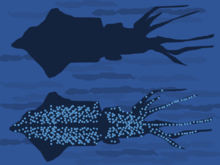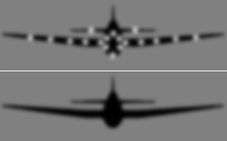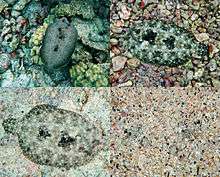Counter-illumination
Counter-illumination is a method of camouflage in which an animal (or possibly a military vehicle) produces light to match an illuminated background, such as the ocean surface or sky. It differs from countershading which uses only pigment, such as a vehicle's paint or the melanin in an animal's skin, to paint out the appearance of shadows. By adding the right amount of light through bioluminescence or electronically controlled lamps, counter-illumination can at best exactly match the brightness of the background, making for more effective camouflage than countershading can provide. Since counter-illumination allows the intensity of the generated light to be adjusted, camouflage can be actively adapted to varying lighting conditions and backgrounds.
Counter-illumination is one of the dominant methods of camouflage in marine organisms, along with transparency and silvering. All three methods make animals in open water resemble their environment.
Principle

Among marine organisms, counter-illumination camouflage occurs where bioluminescent light from an organism's ventral surface[1] is matched to the light radiating from the environment. The bioluminescence is used to obscure the organism's silhouette produced by the down-welling light.[2] Some midwater cephalopods such as the firefly squid, decapod crustaceans, and deep ocean fishes utilize this form of camouflage.[3]
The bioluminescence used for Counter-illumination can be either autogenic (produced by the animal itself) or bacteriogenic (produced by bacterial symbionts).[4] The luminescent bacterium is often Aliivibrio fischeri.[5]
Reducing the organism's silhouette is primarily an anti-predator defence for mesopelagic (mid-water) organisms. The reduction of the silhouette from highly directional down-welling light is important as there is no refuge in the mesopelagic, and predation occurs from below.[1][6][7]
Examples of the strategy
Many species in the mesopelagic areas of the ocean utilize this alternative to countershading. For these marine species, counter-illumination best serves them when ambient light levels are low, leaving the diffuse down-welling light from above as the only light source.[2]
At night, nocturnal organisms match the wavelength and light intensity of their bioluminescence to that of the down-welling moonlight and direct it downward as they swim, to help them remain unnoticed by any observers below.[8] This strategy has been shown to significantly reduce predation among individuals employing it over those not employing it in the fish species Porichthys notatus, the plainfin midshipman.[9]
Besides its effectiveness as a predator avoidance mechanism, counter-illumination also serves as an essential tool to predators themselves. Some shark species, such as the deepwater Etmopterus spinax, use counter-illumination to remain hidden from their prey.[10] another example would be the Bobtail squid, which also uses counter-illumination as a means of predation.[11]
Other well-studied examples include the cookiecutter shark, the marine hatchetfish, and the Hawaiian bobtail squid.[12] More than 10% of shark species may be bioluminescent, though some such as the lantern sharks may use the light for signalling as well as for camouflage.[13]
Military applications

Counter-illumination has rarely been used for military purposes. "Diffused lighting camouflage", in which light was projected on to the sides of ships to match the faint glow of the night sky, was trialled by Canada's National Research Council during World War II. The Canadian concept was trialled in American aircraft including B-24 Liberators and TBM Avengers in the Yehudi lights project, using forward-pointing lamps automatically adjusted to match the brightness of the sky.[14]
Active camouflage could in theory exploit counterillumination in both the visible and other parts of the electromagnetic spectrum. BAE Systems's Adaptiv prototypes the use of infrared camouflage technology with about 1000 rapidly heated and cooled Peltier plate panels to cover the sides of an armoured vehicle, providing crypsis by matching the background, or mimesis by depicting an object such as a car when viewed in infrared.[15][16]
Footnotes
- 1 2 Young. R.E, Roper. C.F.E. 1977. Intensity Regulation of Bioluminescence during Countershading in Living midwater animals. Science, New Series. Vol 191,4231: 1046-1048.
- 1 2 Jones(2004): p.1151
- ↑ Jones(2004): Young 1977, as cited by Jones et al. 2004
- ↑ (Jones et al. 2004)
- ↑ Jones. B.W, Nishiguchi. M.K. 2004. Counterillumination in the Hawaiian bobtail squid, Euprymna scolpes Berry (Mollusca: Cephalopoda). Marine Biology. 144:1151-1155.
- ↑ Young. R.E, Roper. C.F.E. 1976. Bioluminescent countershading in Midwater Animals from living Squid. Science, New Series. Vol 191,4231: 1046-1048.
- ↑ "Science & Nature - Sea Life - Ocean info - Counter-illumination". BBC. 2004-03-11. Retrieved 2012-10-03.
- ↑ Guerrero-Ferreira(2009): p.307
- ↑ Jones(2004): Harper 1999, as cited by Jones et al. 2004
- ↑ Claeus(2010): p.28
- ↑ Jones. B.W, Nishiguchi. M.K. 2004. Counterillumination in the Hawaiian bobtail squid, Euprymna scolpes Berry (Mollusca: Cephalopoda). Marine Biology. 144:1151-1155.
- ↑ Jones(2004): p.1154
- ↑ Davies, Ella (26 April 2012). "Tiny sharks provide glowing clue". BBC. Retrieved 12 February 2013.
- ↑ "BBC News Technology". Tanks test infrared invisibility cloak. BBC. 5 September 2011. Retrieved 13 June 2012.
- ↑ "Adaptiv-A Cloak of Invisibility". BAE Systems. 2011. Retrieved 13 June 2012.
References
- Claes, Julien M.; Aksnes, Dag L.; Mallefet, Jérôme (2010). "Phantom hunter of the fjords: camouflage by counterillumination in a shark (Etmopterus spinax)" (PDF). Journal of Experimental Marine Biology and Ecology. 388 (1–2): 28–32. doi:10.1016/j.jembe.2010.03.009.
- Guerrero-Ferreira, R. C.; Nishiguchi, M. K. (2009). "Ultrastructure of light organs of loliginid squids and their bacterial symbionts: a novel model system for the study of marine symbioses". Vie et Milieu. 59 (3–4): 307–313. ISSN 0240-8759.
- Jones, B. W.; Nishiguchi, M. K. (2004). "Counterillumination in the hawaiian bobtail squid, Euprymna scolopes Berry (Mollusca : Cephalopoda)" (PDF). Marine Biology. 144 (6): 1151–1155. doi:10.1007/s00227-003-1285-3.
External links
- Scientific American: 10 Bioluminescent Creatures
- Science Magazine: Bioluminescence in Mesopelagic Squid
- Nova: Science Now: Glowing in the Dark (Squid Abralia veranyi belly lights)

.jpg)